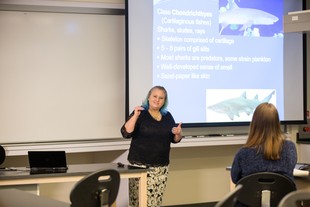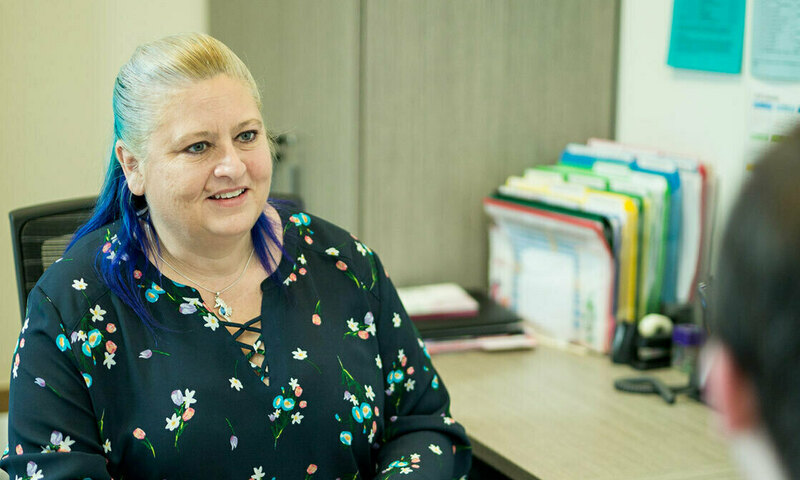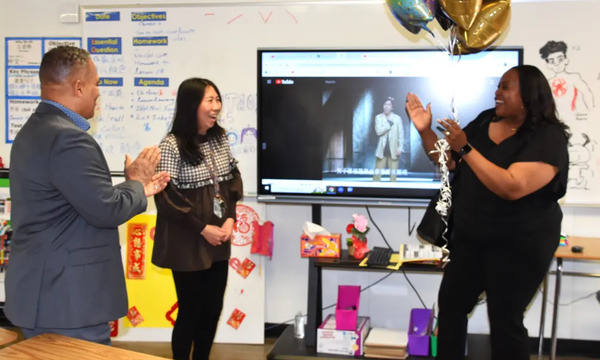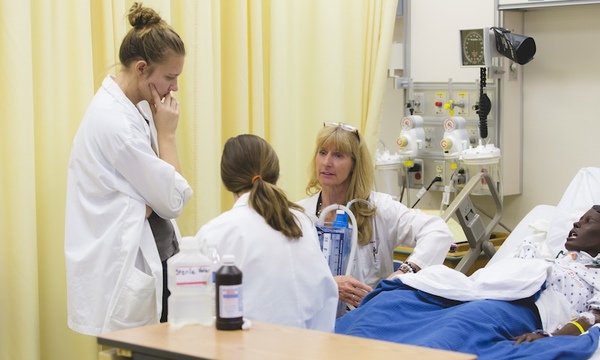Wendy Billock has taught biology at Biola for more than a decade. Her blue hair and title of “Sensei” — she holds third degree black belts in both karate and kobudo and teaches weekly at a dojo near her home — may not be what you expect when you think of a science professor. Yet, her passion for creativity and desire to instill respect and confidence in her karate students bleeds into how she teaches and approaches science as chair of Biola’s biological sciences department.
Billock, who received her doctorate in biology from Loma Linda University conducting research on hermit crab behavior, has a mission to ensure students succeed, whatever challenges they may face. In her classroom and across Biola’s School of Science, Technology and Health, she is pushing curriculum changes to attain that goal. Leading a team of faculty to assess current teaching methods in STEM courses, they will attend a research seminar this summer offered by the Council of Independent Colleges (CIC) through the support of a $300,000 grant from the W. M. Keck Foundation and use the findings to improve teaching methods and build best practices into science courses at Biola.
Her work extends globally. She is traveling to Uganda to visit the Uganda Christian University (UCU) funded by a grant through Council for Christian Colleges & Universities (CCCU) this month and, in June, she will lead a team of teachers to a remote area on the northwest coast of Haiti — her sixth trip to Haiti and fourth time directing a teachers training conference in Bouflette, Haiti. Several hundred teachers will be in attendance to learn teaching techniques, science and humanities curriculum, and how to integrate biblical principles into each lesson they teach.
In addition to her students, Billock seeks to mentor and train women in leadership skills so they can advance in their careers. She recently spoke at the Advancing Women in Leadership conference on transformative leadership.
Here, Billock shares how she integrates faith with science, her recent chapter on bees in the book “God and the World of Insects,” and her work to encourage women and minorities interested in STEM fields.
Can you share more about your research and the conference you recently spoke at on women in higher education leadership?
The first conference was the regional AAC&U Project Kaleidoscope meeting for Equity and Inclusivity in STEM Education. The title of my presentation was “Bridging the Confidence Gap: Gender differences in perceived aptitude versus academic performance”. We analyzed the data from incoming freshmen surveys and found that even though female students reported a significantly higher GPA in high school, and had taken the same number of math, science, and AP courses in high school, they were less confident than male students entering a STEM major at Biola. Female students rated themselves lower in creativity, leadership ability, and risk-taking. What was most surprising is that male students rated themselves significantly higher than female students in academic ability and intellectual self-confidence even though on average female students did just as well, if not better, than male students in high school. Some say that the lack of women in STEM careers is due to a “leaky pipeline” that causes more females than males to leave STEM along the way in their education. If we can identify some of the reasons that females leave before completing their degree in STEM we can address those needs so that more women complete their degrees and enter their chosen profession.
You are the team leader for a project recently funded by a grant from the Council of Independent Colleges. What will the grant allow you to study?
For generations, science courses have been taught primarily through lecture. Students that did well on lecture-based tests were thought to be “good at science” while those that did poorly on those tests were assumed to lack the aptitude to be scientists. Scores on traditional tests can indicate how much of the information was memorized, but it does not help students to achieve the necessary skills to be a good scientist. There are a variety of critical thinking skills that are necessary, but seldom developed in a lecture such as: critical thinking; understanding cause and effect; making relevant predictions; applying the appropriate model or method in a given situation; recognizing relevant and irrelevant information; choosing an appropriate formula, test, or method to achieve a desired result; and checking the correctness or appropriateness of a potential solution. Often these important skills are not taught in freshmen level courses, if at all, during the undergraduate curriculum.
During the summer of 2019 a team of four Biola faculty members will attend workshops to learn new active-learning strategies tested and promoted by Nobel-laureate in physics, Carl Wieman thanks to the grant. These methods are based on the neuroscience of how students learn when they are acquiring a new skill such as science, mathematics or engineering.
How will the work you're conducting impact Biola classrooms?
Research has shown that novel teaching strategies, such as flipped classrooms or inquiry-based learning, results in significantly higher learning gains in underrepresented students compared to majority students’ learning gains. We are thrilled at the prospective of improving learning and graduation rates for the students that have traditionally struggled to make it through STEM majors.
To solve tomorrow’s problems, the nation needs fresh perspectives from people of diverse backgrounds. According to the U.S. Department of Commerce, women only occupy 25 percent of STEM jobs and the U.S. Department of Education reports that although Hispanic and White students enter STEM college programs at the same rate, Hispanic students are significantly less likely to finish their degree in STEM. These are just a couple of examples of underrepresented groups in STEM. It is our desire that all students that enter a STEM program at Biola find the support and training they need to succeed.
You wrote a chapter in a book last year on bee vision. What do you find fascinating about bees?
For a portion of my PhD research, I studied hermit crab vision. Their compound eyes are similar to bees and other insects. Bees have the hallmarks of design. They possess color vision, ultraviolet vision, polarized-light sensitivity, the ability to compensate for the sun’s movement across the sky, an internal sense of time, a dance-language system of communication, a keen sense of smell, distance estimation skills, muscle memory, and a magnetic compass. Although bee vision is less acute than human’s, which means that the image is not as sharp, their vision is much faster. A video need only be at 16 frames per second for humans to perceive motion. The highest HDTV televisions project at 60 frames per second. Bee brains process images so fast that they would need to view a video filmed at 300 frames per second to perceive motion; anything slower would appear as separate images and not as continuous movement. All of this is done by a very small animal. I think that bees, and many other invertebrate animals, are excellent examples of micro-engineering and clearly point to an intelligent designer.
Can you share more about how you see faith and science as integrated?
The idea that faith and science are separate is a myth. Every scientist makes assumptions based on prior understanding. If the assumptions are faulty, the interpretation based on those assumptions may lead to wrong conclusions. What is not commonly discussed are the number of assumptions scientists make that are actually faith-based and not evidence-based statements. For example, stating that there is no God is just as much a faith-based statement as saying that there is a God. Universal Common Descent (UCD), that all living things have evolved from a common ancestor, is probably the most controversial definition of evolution. UCD has a large number of faith-based assumptions built into the theory that are not based on supporting evidence, such as: living cells can arise spontaneously from non-living material; random, undirected processes are creative and lead to greater order and complexity; and that mutations are beneficial and improve species over time.

A better explanation of the scientific evidence is that living things are designed. As a Christian, I have come to know who the designer is. God describes His creative work in the Bible. At Biola, we are able to discuss the strengths and weakness of evolution. For example, natural selection does preserve useful traits in the genetic code to some extent. The origin of traits, however, cannot be explained by random mutations occurring over time. A better explanation is that God is the intelligence behind the information contained in the genetic code. I see beauty in all of God’s creativity and I enjoy discussing His living artwork with my students. The evidence of creation and the fall is all around us, if we are open to seeing it.
How do you prepare students to work in a field that may see their faith at odds with their scientific work?
There are three parts to preparing for work in a largely secular scientific community. The first is to understand the details of the majority-held viewpoint, the second is to understand the strengths and weaknesses of that viewpoint, and the third is to provide an alternative viewpoint that surpasses the majority-held viewpoint based on the scientific data.
The secular viewpoint is the majority-held view in many fields such as the origin of species, bioethics, and conservation. At Biola University, students are prepared to defend why intelligent design is a better explanation than evolution, why a Christian worldview leads to more ethical healthcare and scientific research, and why God’s command to steward His creation informs equitable and sustainable conservation policies. Because we train students to consider all sides of the debate, Biola students are better prepared to think critically than those who have only been exposed to a single viewpoint.
Biola’s School of Science, Technology and Health will launch the following three new programs in fall 2019: Bachelor of Science in Applied Physics, Bachelor of Science in Public Health, and Bachelor of Science in Health Science.
Learn more about Biola’s School of Science, Technology and Health programs and apply now.
 Biola University
Biola University

.jpg)

_(1).jpeg)